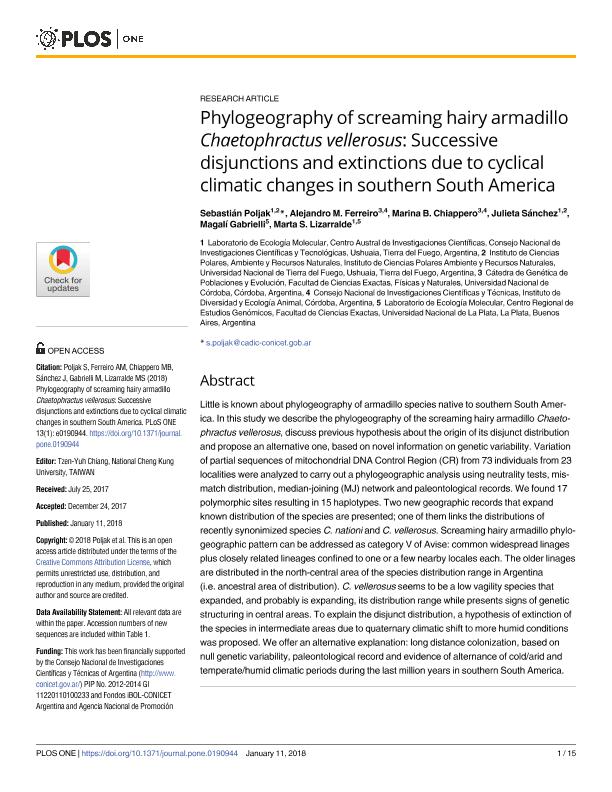Mostrar el registro sencillo del ítem
dc.contributor.author
Poljak, Sebastián

dc.contributor.author
Ferreiro, Alejandro Manuel

dc.contributor.author
Chiappero, Marina Beatriz

dc.contributor.author
Sánchez, Julieta
dc.contributor.author
Gabrielli, Magali

dc.contributor.author
Lizarralde, Marta Susana

dc.date.available
2018-11-02T20:20:54Z
dc.date.issued
2018-01
dc.identifier.citation
Poljak, Sebastián; Ferreiro, Alejandro Manuel; Chiappero, Marina Beatriz; Sánchez, Julieta; Gabrielli, Magali; et al.; Phylogeography of screaming hairy armadillo Chaetophractus vellerosus: Successive disjunctions and extinctions due to cyclical climatic changes in southern South America; Public Library of Science; Plos One; 13; 1; 1-2018; 1-15
dc.identifier.issn
1932-6203
dc.identifier.uri
http://hdl.handle.net/11336/63557
dc.description.abstract
Little is known about phylogeography of armadillo species native to southern South America. In this study we describe the phylogeography of the screaming hairy armadillo Chaetophractus vellerosus, discuss previous hypothesis about the origin of its disjunct distribution and propose an alternative one, based on novel information on genetic variability. Variation of partial sequences of mitochondrial DNA Control Region (CR) from 73 individuals from 23 localities were analyzed to carry out a phylogeographic analysis using neutrality tests, mismatch distribution, median-joining (MJ) network and paleontological records. We found 17 polymorphic sites resulting in 15 haplotypes. Two new geographic records that expand known distribution of the species are presented; one of them links the distributions of recently synonimized species C. nationi and C. vellerosus. Screaming hairy armadillo phylogeographic pattern can be addressed as category V of Avise: common widespread linages plus closely related lineages confined to one or a few nearby locales each. The older linages are distributed in the north-central area of the species distribution range in Argentina (i.e. ancestral area of distribution). C. vellerosus seems to be a low vagility species that expanded, and probably is expanding, its distribution range while presents signs of genetic structuring in central areas. To explain the disjunct distribution, a hypothesis of extinction of the species in intermediate areas due to quaternary climatic shift to more humid conditions was proposed. We offer an alternative explanation: long distance colonization, based on null genetic variability, paleontological record and evidence of alternance of cold/arid and temperate/humid climatic periods during the last million years in southern South America.
dc.format
application/pdf
dc.language.iso
eng
dc.publisher
Public Library of Science

dc.rights
info:eu-repo/semantics/openAccess
dc.rights.uri
https://creativecommons.org/licenses/by-nc-sa/2.5/ar/
dc.subject
Chaetophractus Vellerosus
dc.subject
Phylogeography
dc.subject
Mtdna Control Region
dc.subject
Long Distance Colonzation
dc.subject
Pampean Region
dc.subject
Disjunct Distribution
dc.subject.classification
Otras Ciencias Biológicas

dc.subject.classification
Ciencias Biológicas

dc.subject.classification
CIENCIAS NATURALES Y EXACTAS

dc.title
Phylogeography of screaming hairy armadillo Chaetophractus vellerosus: Successive disjunctions and extinctions due to cyclical climatic changes in southern South America
dc.type
info:eu-repo/semantics/article
dc.type
info:ar-repo/semantics/artículo
dc.type
info:eu-repo/semantics/publishedVersion
dc.date.updated
2018-10-19T15:07:03Z
dc.journal.volume
13
dc.journal.number
1
dc.journal.pagination
1-15
dc.journal.pais
Estados Unidos

dc.journal.ciudad
San Francisco
dc.description.fil
Fil: Poljak, Sebastián. Consejo Nacional de Investigaciones Científicas y Técnicas. Centro Austral de Investigaciones Científicas; Argentina. Universidad Nacional de Tierra del Fuego, Antártida e Islas del Atlántico Sur. Instituto de Ciencias Polares, Recursos Naturales y Ambiente. Departamento de Biología; Argentina
dc.description.fil
Fil: Ferreiro, Alejandro Manuel. Consejo Nacional de Investigaciones Científicas y Técnicas. Centro Científico Tecnológico Conicet - Córdoba. Instituto de Diversidad y Ecología Animal. Universidad Nacional de Córdoba. Facultad de Ciencias Exactas Físicas y Naturales. Instituto de Diversidad y Ecología Animal; Argentina
dc.description.fil
Fil: Chiappero, Marina Beatriz. Consejo Nacional de Investigaciones Científicas y Técnicas. Centro Científico Tecnológico Conicet - Córdoba. Instituto de Diversidad y Ecología Animal. Universidad Nacional de Córdoba. Facultad de Ciencias Exactas Físicas y Naturales. Instituto de Diversidad y Ecología Animal; Argentina
dc.description.fil
Fil: Sánchez, Julieta. Universidad Nacional de Tierra del Fuego, Antártida e Islas del Atlántico Sur. Instituto de Ciencias Polares, Recursos Naturales y Ambiente. Departamento de Biología; Argentina. Consejo Nacional de Investigaciones Científicas y Técnicas. Centro Austral de Investigaciones Científicas; Argentina
dc.description.fil
Fil: Gabrielli, Magali. Consejo Nacional de Investigaciones Científicas y Técnicas; Argentina. Universidad Nacional de La Plata. Centro Regional de Estudios Genómicos; Argentina
dc.description.fil
Fil: Lizarralde, Marta Susana. Universidad Nacional de La Plata. Centro Regional de Estudios Genómicos; Argentina. Consejo Nacional de Investigaciones Científicas y Técnicas; Argentina
dc.journal.title
Plos One

dc.relation.alternativeid
info:eu-repo/semantics/altIdentifier/url/https://journals.plos.org/plosone/article?id=10.1371/journal.pone.0190944
dc.relation.alternativeid
info:eu-repo/semantics/altIdentifier/doi/https://doi.org/10.1371/journal.pone.0190944
Archivos asociados
